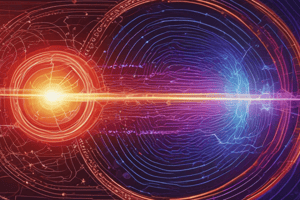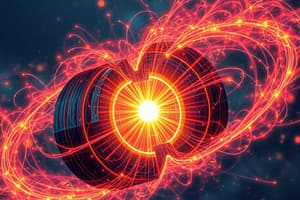Podcast
Questions and Answers
How did Faraday's discovery of electromagnetic induction differ from Oersted's discovery?
How did Faraday's discovery of electromagnetic induction differ from Oersted's discovery?
- Faraday discovered that magnetism could produce electricity, while Oersted discovered that electricity could produce magnetism. (correct)
- Faraday demonstrated the conversion of electrical energy into mechanical energy, while Oersted showed the opposite.
- Faraday's experiment required a closed circuit, while Oersted's did not.
- Faraday discovered the relationship between magnetism and electricity, while Oersted focused solely on the properties of magnets.
A scientist wants to maximize the induced voltage in a coil of wire using electromagnetic induction. Which combination of actions would be most effective?
A scientist wants to maximize the induced voltage in a coil of wire using electromagnetic induction. Which combination of actions would be most effective?
- Using a weaker magnet and moving it slowly in and out of a coil with fewer turns.
- Using a weaker magnet and keeping it stationary near a coil with more turns.
- Using a stronger magnet and moving it quickly in and out of a coil with more turns. (correct)
- Using a stronger magnet and moving it slowly in and out of a coil with fewer turns.
A galvanometer deflects to the right when the North Pole of a magnet is plunged into a coil. What would cause the galvanometer to deflect to the left?
A galvanometer deflects to the right when the North Pole of a magnet is plunged into a coil. What would cause the galvanometer to deflect to the left?
- Holding the magnet stationary inside the coil.
- Decreasing the speed at which the magnet is plunged into the coil.
- Plunging the South Pole of the magnet into the coil. (correct)
- Using a coil with fewer turns.
A coil with 50 turns of wire produces an induced voltage of $V$ volts when a magnet is moved near it. Assuming all other factors remain constant, what induced voltage would you expect if the coil had 200 turns?
A coil with 50 turns of wire produces an induced voltage of $V$ volts when a magnet is moved near it. Assuming all other factors remain constant, what induced voltage would you expect if the coil had 200 turns?
Which of the following is NOT a factor directly affecting the magnitude of induced voltage in electromagnetic induction?
Which of the following is NOT a factor directly affecting the magnitude of induced voltage in electromagnetic induction?
Which of the following components is present in both electric motors and generators?
Which of the following components is present in both electric motors and generators?
A device requires 110V to operate but is connected to a 220V power supply. Which type of transformer is needed and what is its function?
A device requires 110V to operate but is connected to a 220V power supply. Which type of transformer is needed and what is its function?
In an electric generator, what is the primary purpose of the magnet?
In an electric generator, what is the primary purpose of the magnet?
Which of the following best describes the energy conversion that takes place within an electric motor?
Which of the following best describes the energy conversion that takes place within an electric motor?
How does a generator differ fundamentally from an electric motor in terms of energy input?
How does a generator differ fundamentally from an electric motor in terms of energy input?
Flashcards
Electromagnetic Induction
Electromagnetic Induction
The process of using magnetic fields to produce voltage and current in a closed circuit.
Michael Faraday
Michael Faraday
First scientist to investigate electromagnetic induction, observing induced voltage through magnet movement.
Galvanometer
Galvanometer
An instrument that detects and measures small amounts of current in an electrical circuit.
Faraday’s Law
Faraday’s Law
Induced voltage magnitude is proportional to the rate of change in magnetic flux and the number of coil turns.
Signup and view all the flashcards
Factors Affecting Induced Voltage
Factors Affecting Induced Voltage
Involves changes in magnetic field, speed of movement, and number of coil turns affecting induced voltage.
Signup and view all the flashcards
Electric Motors
Electric Motors
Devices that convert electrical energy into mechanical energy.
Signup and view all the flashcards
Components of Electric Motors
Components of Electric Motors
Parts include Armature, Brushes, Commutators, Field Coil, and Permanent Magnet.
Signup and view all the flashcards
Generators
Generators
Devices that convert mechanical energy into electrical energy.
Signup and view all the flashcards
Components of Generators
Components of Generators
Parts include Armature, Brushes, Commutator, Wire Coil, and Magnet.
Signup and view all the flashcards
Transformers
Transformers
Devices that change voltage levels in electrical circuits.
Signup and view all the flashcardsStudy Notes
Electromagnetic Induction
- Faraday's work differed from Oersted's by demonstrating that magnetism could induce electricity, unlike Oersted's observation of electricity creating magnetism.
- Electromagnetic induction is the process of generating voltage and current in a closed circuit via magnetic fields. This principle underpins transformers, motors, and generators.
Michael Faraday
- He pioneered the investigation of electromagnetic induction.
- Faraday’s observations included:
- Relative motion: Movement (of either coil or magnet) is necessary for induction.
- Pole reversal: Changing the magnetic pole's orientation affects the current direction.
- Speed: Faster movement leads to greater induced current.
- Number of turns: Increasing coil turns increases induced voltage.
Galvanometer
- A galvanometer measures small electric currents.
Faraday's Law
- The induced voltage is proportional to the rate of magnetic flux change and number of coil turns.
Factors Affecting Induced Voltage
- Changing magnetic field through a coil.
- Movement speed of either the coil or magnet – faster speed means higher induced voltage.
- Number of coil turns – more turns mean more voltage. (e.g., 20 turns produce 20 times the voltage of a single loop).
Applications
Electric Motors
- Convert electrical energy to mechanical energy (e.g., fan, washing machine).
- Key parts include armature, brushes, commutator, current source, field coil, and permanent magnet.
Generators
- Convert mechanical energy to electrical energy.
- Components include armature, brushes, commutator, wire coil, and a magnet. Generators create current independent of external power sources.
Transformers
- Change voltage magnitudes.
- Step-up transformers increase voltage (e.g., 220V to 110V).
- Step-down transformers decrease voltage (e.g., 220V to 110V).
Studying That Suits You
Use AI to generate personalized quizzes and flashcards to suit your learning preferences.




